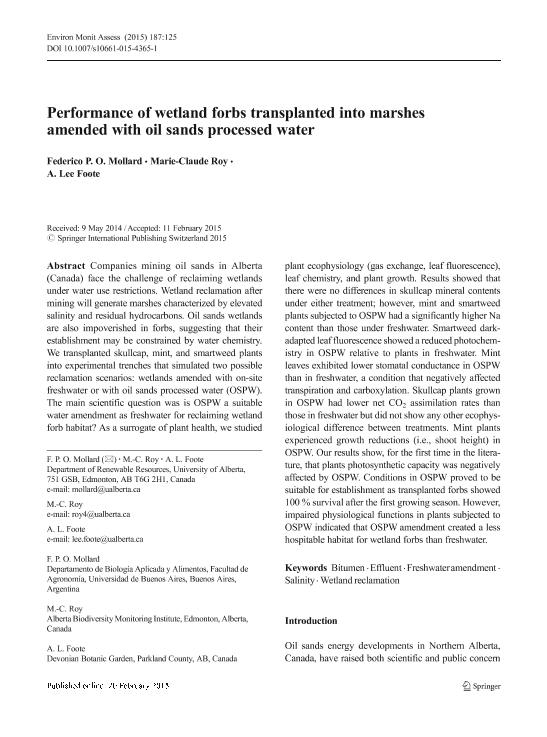Mostrar el registro sencillo del ítem
dc.contributor.author
Mollard, Federico Pedro Otto

dc.contributor.author
Roy, Marie Claude
dc.contributor.author
Lee Foote, A.
dc.date.available
2017-06-02T20:38:44Z
dc.date.issued
2015-03
dc.identifier.citation
Mollard, Federico Pedro Otto; Roy, Marie Claude; Lee Foote, A.; Performance of wetland forbs transplanted into marshes amended with oil sands processed water; Springer; Environmental Monitoring And Assessment; 187; 3-2015; 1-8
dc.identifier.issn
0167-6369
dc.identifier.uri
http://hdl.handle.net/11336/17427
dc.description.abstract
Companies mining oil sands in Alberta (Canada) face the challenge of reclaiming wetlands under water use restrictions. Wetland reclamation after mining will generate marshes characterized by elevated salinity and residual hydrocarbons. Oil sands wetlands are also impoverished in forbs, suggesting that their establishment may be constrained by water chemistry. We transplanted skullcap, mint, and smartweed plants into experimental trenches that simulated two possible reclamation scenarios: wetlands amended with on-site freshwater or with oil sands processed water (OSPW). The main scientific question was is OSPW a suitable water amendment as freshwater for reclaiming wetland forb habitat? As a surrogate of plant health, we studied plant ecophysiology (gas exchange, leaf fluorescence), leaf chemistry, and plant growth. Results showed that there were no differences in skullcap mineral contents under either treatment; however, mint and smartweed plants subjected to OSPW had a significantly higher Na content than those under freshwater. Smartweed darkadapted leaf fluorescence showed a reduced photochemistry in OSPW relative to plants in freshwater. Mint leaves exhibited lower stomatal conductance in OSPW than in freshwater, a condition that negatively affected transpiration and carboxylation. Skullcap plants grown in OSPW had lower net CO2 assimilation rates than those in freshwater but did not show any other ecophysiological difference between treatments. Mint plants experienced growth reductions (i.e., shoot height) in OSPW. Our results show, for the first time in the literature, that plants photosynthetic capacity was negatively affected by OSPW. Conditions in OSPW proved to be suitable for establishment as transplanted forbs showed 100 % survival after the first growing season. However, impaired physiological functions in plants subjected to OSPW indicated that OSPW amendment created a less hospitable habitat for wetland forbs than freshwater.
dc.format
application/pdf
dc.language.iso
eng
dc.publisher
Springer

dc.rights
info:eu-repo/semantics/openAccess
dc.rights.uri
https://creativecommons.org/licenses/by-nc-sa/2.5/ar/
dc.subject
Bitumen
dc.subject
Effluent
dc.subject
Freshwater Amendment
dc.subject
Salinity
dc.subject
Wetland Reclamation
dc.subject.classification
Ciencias Medioambientales

dc.subject.classification
Ciencias de la Tierra y relacionadas con el Medio Ambiente

dc.subject.classification
CIENCIAS NATURALES Y EXACTAS

dc.subject.classification
Ciencias de las Plantas, Botánica

dc.subject.classification
Ciencias Biológicas

dc.subject.classification
CIENCIAS NATURALES Y EXACTAS

dc.title
Performance of wetland forbs transplanted into marshes amended with oil sands processed water
dc.type
info:eu-repo/semantics/article
dc.type
info:ar-repo/semantics/artículo
dc.type
info:eu-repo/semantics/publishedVersion
dc.date.updated
2017-06-02T17:32:43Z
dc.identifier.eissn
1573-2959
dc.journal.volume
187
dc.journal.pagination
1-8
dc.journal.pais
Suiza

dc.description.fil
Fil: Mollard, Federico Pedro Otto. University of Alberta; Canadá. Universidad de Buenos Aires. Facultad de Agronomia. Departamento de Biología Aplicada y Alimentos; Argentina. Consejo Nacional de Investigaciones Científicas y Técnicas; Argentina
dc.description.fil
Fil: Roy, Marie Claude. University of Alberta; Canadá
dc.description.fil
Fil: Lee Foote, A.. University of Alberta; Canadá
dc.journal.title
Environmental Monitoring And Assessment

dc.relation.alternativeid
info:eu-repo/semantics/altIdentifier/doi/http://dx.doi.org/10.1007/s10661-015-4365-1
dc.relation.alternativeid
info:eu-repo/semantics/altIdentifier/url/https://link.springer.com/article/10.1007%2Fs10661-015-4365-1
Archivos asociados
